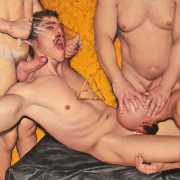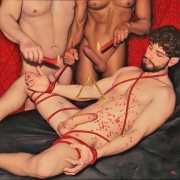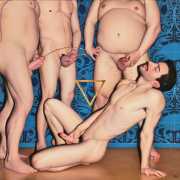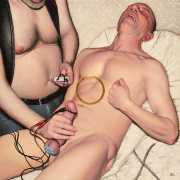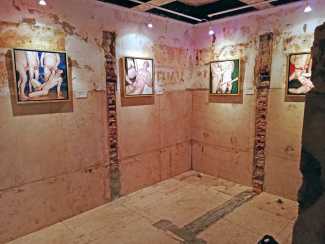 In an disused underground lavatory in Lisbon in the autumn of 2020, Barahona Possolo displayed a set of five small homoerotic fetish paintings. At one time during the Estado Novo dictatorship, roughly the mid-1930s until the 1960s, the cramped space was a well-known place for male sexual encounters, and repeatedly the target of police raids. The novel setting for the project reminds us of the repression that persists in society against the nature of explicit sexual images, and Behind the Green Door, the title of the exhibition which quotes a famous pornographic film from the 1970s, seek to liberate prejudices about gay sexuality.
In an disused underground lavatory in Lisbon in the autumn of 2020, Barahona Possolo displayed a set of five small homoerotic fetish paintings. At one time during the Estado Novo dictatorship, roughly the mid-1930s until the 1960s, the cramped space was a well-known place for male sexual encounters, and repeatedly the target of police raids. The novel setting for the project reminds us of the repression that persists in society against the nature of explicit sexual images, and Behind the Green Door, the title of the exhibition which quotes a famous pornographic film from the 1970s, seek to liberate prejudices about gay sexuality.
The five paintings are titled Air, Earth, Fire, Water, and Spirit.
The journalist Francisco Vaz Fernandes interviewed Possollo during the mini-exhibition; here are some of his replies.
Exhibiting in an old public toilet is somewhat bizarre. Did the space suggest the paintings, or did the homoerotic theme help you find the location?
The space miraculously presented itself after the paintings began to be made. The transgressive nature of the theme posed a problem regarding the form of presentation, which seemed very difficult to resolve, but when the solution emerged the problem became a positive advantage.
What references did you bring to your paintings?
The initial intention was to reveal the presence of the sacred in a traditionally demonised territory – so demonised that everything about it was relegated to illegality, silence and shame. To try to demonstrate this presence of the sacred I sought the symbolism of the five alchemical elements, widely disseminated in artistic iconography, as tutelary essences. In each painting the gold symbol occupies the graphic centre.
What do you say to people who might think your work is obscene?
Obviously I do not intend to bring obscenity into everyday public social practices, but I do want to remember the normality of so many varied forms of sexuality that are hypocritically hidden or even criminalised. The Estado Novo, which many no longer remember (or say they don't remember) was a fierce enemy of individuality and free thought; many people different from the miserable norm were tortured and killed. Today it is denialism that can allow monstrous atrocities to be repeated. Freedom is something you have to fight for daily. If we start to give up on it, someone will immediately take advantage of it.
Do you believe that there is a queer art, and do you consider yourself included?
Without being able to define exactly the boundaries of queer art, I believe that yes, it exists. And I have always felt included in itt. When I started painting I chose a symbolic figurative genre with a naturalistic aspect, which was completely rejected by critics and the mainstream who consider themselves avant-garde, but I feel it is the appropriate genre for the subjects I want to explore.
Would you say that your paintings represent something basically true and natural?
I certainly believe in the naturalness of humans, the unique and specific shape that each of us has. We are all different in our uniqueness but we are all equal, legitimate individual explorers of humanity. The people in my paintings exist; each one of them is invaluable and without each one of them it would have been impossible to create the canvases.
The old lavatory is in the process of being redeveloped; do you know what future is planned for the space?
The Parish of Santo António intends for it to be a new exhibition space. Although small in area, its location is wonderful, and I hope it will be sought after by artists of all genres and ages.


